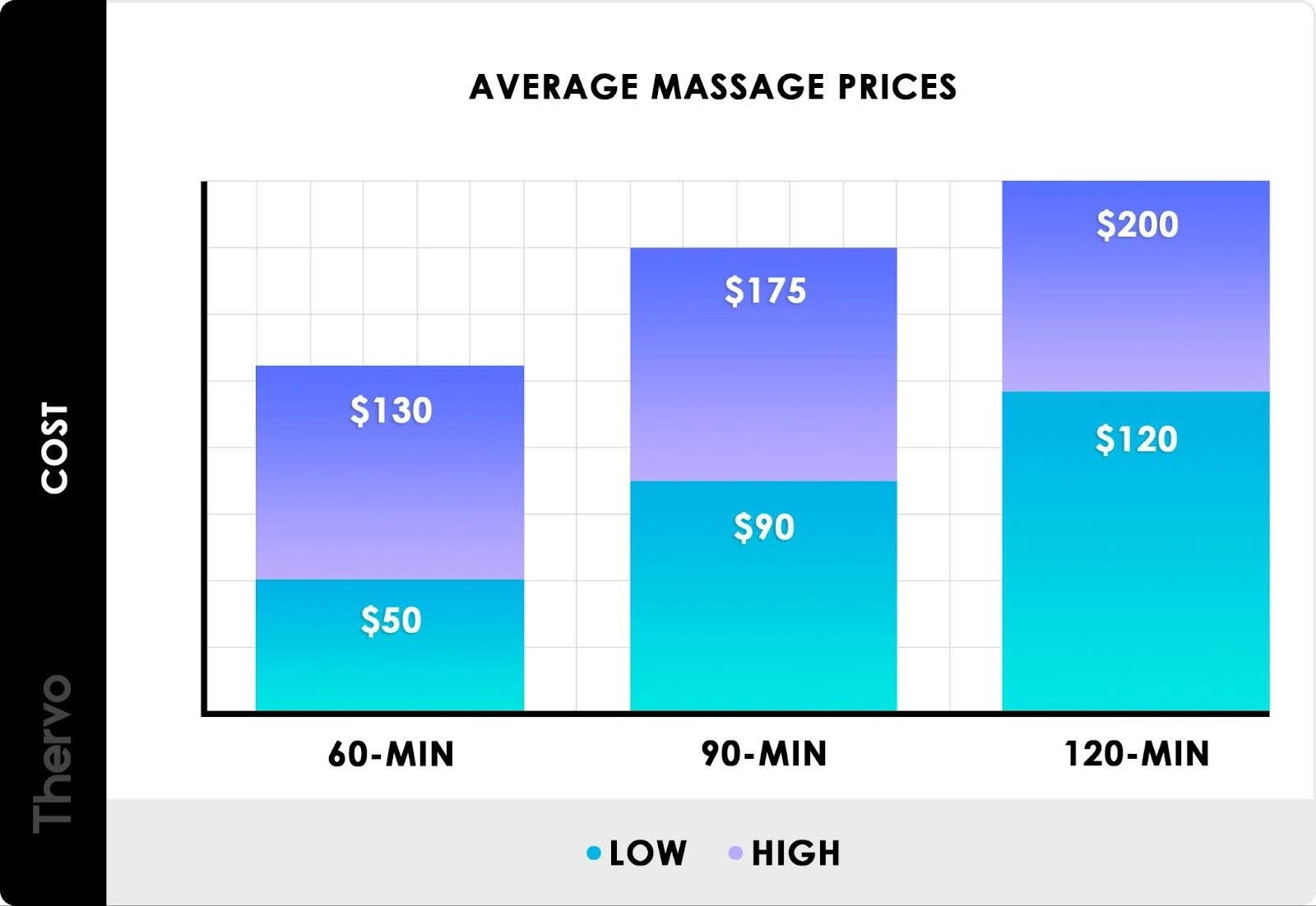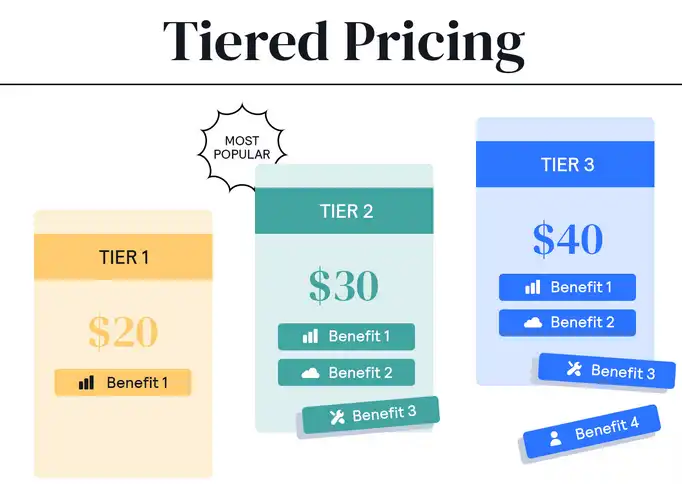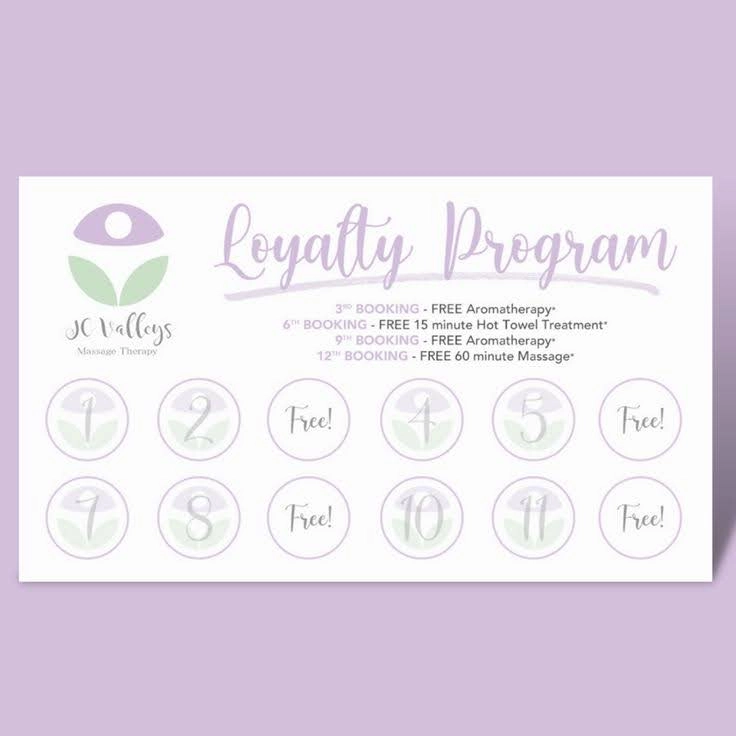Cyber Monday Offer is Here! Subscribe by December 5 to Get 3 Months Free!
Learn More
Table of Contents

Experience Better Practice Management Today!
Starting at $28.05/month
No Credit Card Required

Experience Better Practice Management Today!
Starting at $30/month
No Credit Card Required
Before you can set your massage prices, it's essential to understand the current market landscape. Pricing in the massage therapy industry can vary significantly based on factors like location, type of service, and client demographics.
Knowing the national and regional averages and how different services are priced gives you a solid foundation to build a competitive pricing strategy.
Here’s a breakdown of typical massage therapy prices across the U.S., considering national averages and regional variations:

Different types of massage services come with varying price points based on factors like the type of treatment, session length, and added luxuries.
A standard Swedish massage, typically seen as a relaxation treatment, might cost around $60 for a 60-minute session.
On the other hand, more specialized services like deep tissue or sports massage, which require specific expertise and provide therapeutic benefits, usually have higher rates - typically exceeding $100 for the same time frame.
Additional services such as hot stone therapy, prenatal massages, or aromatherapy add-ons can further elevate the pricing by positioning your services as more luxurious or tailored to client needs.
The cost of a massage also varies depending on the session length. Here’s a breakdown of typical prices:
These prices can fluctuate based on factors like location, the therapist’s expertise, and the type of massage offered.
I've seen this come up a lot when therapists move or open in a new area. Your rates might’ve made sense in a smaller town, but in a busy metro or tourist spot, clients usually expect and are willing to pay for something higher.
Same goes for who you’re serving. If your client base skews younger, they may be more price-sensitive. But older clients or folks dealing with chronic issues tend to value the therapeutic side and they’re often fine paying a bit more for it.
Where you are and who you're serving should both play into how you set your pricing.
Setting the right massage price for your massage therapy services is not just about covering costs; it involves a deep understanding of multiple factors that affect both your profitability and your clients’ perception of value.
Each of these elements plays a critical role in creating a pricing structure that’s competitive yet sustainable.
Cost of Goods Sold (COGS) includes all the expenses that are directly related to running your business. This covers everything from labor costs, such as your salary and any staff you employ, to operational expenses like rent, utilities, and equipment, including massage tables, oils, and linens.
It’s important not to overlook the smaller, recurring costs like laundry, cleaning supplies, and massage therapist insurance that quietly add up and keep your clinic running. I’ve also seen therapists forget to factor in billing time, especially if they’re submitting claims or sending receipts after each session.
That time counts. Missing these details can lead to underpricing, and over time, that cuts into your profit more than you think.
I’ve learned that until you really know your fixed and variable costs, it’s almost impossible to price your services properly. You need to cover your expenses and still leave enough margin to make it worth your time.
Customers often associate higher prices with higher quality, and many are willing to pay more if your clinic offers a premium experience. This can include a luxurious setting, personalized services, or specialized treatments such as sports massage or prenatal care.
The ambiance of your clinic, the professionalism of your staff, and the overall experience you provide can significantly impact how much clients are willing to pay for your services.
In my experience, it is important to recognize that perceived value doesn’t always require a high-end spa setup. Your expertise, customer care, and attention to detail can enhance your services’ value and justify higher prices.
While knowing what your competitors are charging is important, do not simply copy their rates. Your unique selling points (USPs), such as your certifications, experience, or specialized services, should justify your pricing and differentiate you from others in the market.
I’ve found that knowing where your competitors sit in the market makes a big difference. It helps you figure out if you’re positioning yourself as the higher-value option or if you’re aiming to be the more affordable choice for clients watching their budget.
Highlighting what makes your services unique can justify premium pricing. Whether it’s years of experience, advanced certifications, or a specific niche like sports or prenatal massage, these elements can differentiate you from others in your area and allow you to charge more.
Clients are often willing to pay a higher price for specialized services they can’t easily find elsewhere. By emphasizing your unique offerings, you can position your clinic as a premium choice for clients seeking specialized care.
Developing a structured approach to pricing your massage therapy services is essential for maintaining profitability and attracting clients. Below, we outline five key steps to help you set your prices strategically while avoiding common pitfalls.
Knowing the costs to run your business is essential before setting your prices. Start by listing all your fixed costs, such as rent, utilities, insurance, and equipment.
Next, factor in your variable costs like massage oils, linens, and laundry. Don’t overlook smaller expenses like cleaning supplies and marketing they can add up quickly! Having a clear picture of your total costs ensures you’re pricing your services correctly to cover all expenses and still make a profit.
Common Mistake
A common oversight is not including your own salary in the cost calculation. As a business owner, your time is valuable, and your pricing should reflect a fair wage that supports your livelihood.
It’s important to check what other therapists in your area are charging. Compare their service quality, experience, and pricing structure to get a sense of the local market. However, avoid basing your pricing solely on your competitors. Instead, focus on your unique value proposition and the experience you offer, which can justify higher or differentiated pricing.
Common Mistake
Many new business owners make the mistake of focusing too heavily on competitor prices without considering their own costs and value proposition. Additionally, ignoring regional differences in pricing can lead to a pricing misalignment with your local market.
Your value proposition is what makes you stand out from others in the massage therapy industry. This could be your years of experience, your therapeutic approach, or the peaceful atmosphere you create in your clinic. It’s essential to clearly communicate this value to your clients to justify your pricing.
When clients understand your unique benefits, they’ll be more willing to accept higher rates, recognizing the quality and specialization you bring to your services.
Common Mistake
Failing to communicate your value clearly can lead to underpricing or overpricing without proper justification. If clients don’t understand what makes your services unique, they may opt for less expensive options, even when your services offer superior value.
Once you've covered your costs, it’s time to set a profit target. How much do you need to earn to ensure your business remains sustainable and continues to grow?
Consider your growth potential, whether it's expanding your services, upgrading equipment, or adding new features, and ensure your prices align with these goals. The goal is to strike a balance between generating a reasonable profit and keeping your services affordable for your target clients.
Common Mistake
Expecting unrealistically high profit margins can lead to overpricing, which may push clients away. On the other hand, setting margins too low can result in overworking with little financial return. Another common mistake is failing to account for future growth, such as expanding services or upgrading equipment, which could limit long-term profitability.
Pricing isn’t set in stone. As your business grows and market conditions change, it’s crucial to revisit your prices regularly. Additionally, stay attuned to client feedback, demand, and overall profitability to ensure your prices reflect the current landscape.
If certain services are consistently booked, it may be time to raise those prices. On the flip side, if bookings slow down, it could indicate the need for price adjustments to remain competitive. Testing and tweaking your pricing strategy over time helps you stay profitable without losing clients.
Common Mistake
Failing to reassess your pricing regularly can result in missed opportunities to increase revenue or cause potential loss of clients due to outdated pricing. On the other hand, frequent and inconsistent pricing changes can confuse clients, damage your reputation, and reduce trust and loyalty.
Once you've established a basic pricing model, you can implement advanced strategies to boost profitability further. These approaches allow you to cater to a broader range of clients, encourage repeat business, and take advantage of peak times while ensuring your services remain profitable.
A tiered pricing model enables you to offer different service levels at various price points, which can appeal to clients with different budgets. This strategy allows you to cater to both budget-conscious clients and those willing to pay more for premium services.
By providing several options, you give clients the flexibility to choose a package that best fits their needs and preferences. It’s an effective way to increase sales while ensuring you meet the demands of a diverse clientele.

Offering memberships or subscription services is a powerful way to establish a consistent revenue stream for your massage therapy business. Clients who sign up for a membership are more likely to schedule regular appointments, providing you with predictable income each month. This setup ensures a steady cash flow, helping you plan and grow your business.
Offering service bundles, such as a series of sessions or packages that include multiple types of massages, is a great way to ensure clients commit to multiple visits. For example, you could offer a discounted rate for clients who book five sessions upfront. Bundling not only encourages clients to return but also increases the overall transaction value.
Dynamic pricing allows you to adjust your rates based on demand, helping you maximize revenue and better manage your schedule. During peak hours, such as weekends or evening appointments, you can slightly increase your rates to reflect the higher demand.
Conversely, during off-peak times, like weekdays or slower hours, you can offer discounted rates to attract more clients. This strategy helps balance your schedule and fills slower times with more affordable pricing, all while maintaining profitability.
Note:
Some therapists shy away from implementing dynamic pricing, fearing it might confuse or alienate clients. However, when communicated clearly and applied consistently, it can actually improve profitability by encouraging clients to book during less busy times.
Charging the same flat rate for every location doesn’t always work when you’re running a mobile practice. Different areas come with different travel times, client expectations, and levels of affluence. Customizing your pricing based on the zones you serve helps ensure you're not undercharging in high-value areas or overcharging in budget-sensitive ones.
This kind of pricing lets you earn what your time’s actually worth without overcomplicating things. Charging more in higher-income or harder-to-reach areas, and adjusting for local zones, keeps things fair for you and clear for your clients.
With Noterro GO, you can make upselling part of your workflow without slowing things down. You can tag services with add-ons, customize options by location, and even track what’s selling best all from your phone.
Choosing the right pricing strategy is essential for ensuring that your massage therapy business thrives. Different approaches offer unique benefits depending on your goals, client base, and market conditions.
Value-based pricing focuses on how much your clients believe your services are worth. This method allows you to set higher prices if you offer something special - whether that’s advanced techniques, a luxurious environment, or personalized care. If your services provide unique value, clients are often willing to pay a premium.
By emphasizing what makes your services stand out, you can justify higher pricing that aligns with the perceived benefits you offer. For instance, if your deep tissue massage helps athletes or clients recovering from injuries, you can price it higher than the market average because of its specific and valuable outcomes.
Cost-plus pricing is a simple and straightforward method where you calculate the total cost of providing a service, including everything from labor and materials to overhead costs. Once you’ve figured out your total cost, you add a profit margin on top. This ensures that all your costs are covered, and you still make a profit.
This approach works well for businesses with predictable costs, providing a clear and easy way to set prices. However, it doesn't always consider market demand or how much clients are willing to pay based on perceived value.
When pricing your services, you can choose to charge based on time (e.g., 60-minute, 90-minute sessions) or based on the type of service (e.g., Swedish massage, hot stone massage).
When setting prices for your services, you have two main options: time-based pricing or service-based pricing. Each method has its advantages and suits different types of services and client preferences.
Time-based Pricing: Time-based pricing is common in the massage industry. This approach allows clients to select the duration of their session, typically 60-minute or 90-minute options, while providing you with a clear structure for your rates.
This method works well for clients who value flexibility and want to choose how long they’ll spend on a massage session. It also makes it easier for you to calculate how much to charge based on the time you dedicate to each client.
How time-based pricing benefits your clinic:
Service-based Pricing: With service-based pricing, you set your rates based on the type of massage you're offering like Swedish, deep tissue, hot stone, or prenatal regardless of the session length.
This model works well when your services vary in complexity, training, or setup. If certain treatments require more prep time, physical effort, or specific equipment, service-based pricing gives you room to reflect that in the cost.
How service-based pricing benefits your clinic:
Effectively communicating your pricing is not only about stating a number; it’s about clearly explaining the value clients receive when they book your services.
I’ve seen that when pricing is clear and upfront, it builds trust right away. Clients know what to expect, which means fewer questions and more confidence in booking. The way you talk about your pricing should feel just as professional as the care you give, and it should remind people why choosing your clinic is worth it.
Clients want to feel confident that they know exactly what they are paying for, and transparency in your pricing is essential to establishing that trust. When clients understand your pricing structure upfront, it sets the tone for a positive, professional relationship.
Pricing is not just about how much you charge but also about the perceived value that clients associate with your services. When discussing your rates, it’s important to emphasize the benefits clients will receive from your expertise and the overall experience you provide.
I’ve seen how much the little things matter, like the relief after a deep tissue session, the calm that comes with aromatherapy, or even just how peaceful your space feels. All of that shapes how clients see the value they’re getting for what they pay.
At times, clients may express concerns about your pricing, especially if it’s higher than they expect. When this happens, it’s important to address their objections with confidence and clarity. Rather than lowering your rates, take the opportunity to explain why your services are priced the way they are.
By communicating the value of your services, you can help clients understand the benefits they will receive and reassure them that the cost reflects the quality of what you offer.
Once your pricing strategy is in place, marketing should align with it to attract clients and reinforce the value of your services. Marketing not only brings in new customers but also justifies your prices by showcasing the benefits of your offerings.
By implementing smart marketing tactics, you can maintain a steady flow of clients while ensuring your pricing is seen as fair and justified.
Offering limited-time promotions or seasonal discounts is a great way to attract new clients, especially during slower periods. By introducing time-sensitive deals, you can incentivize potential clients to try your services, even if they are hesitant to commit at full price.
For example, offering a discount to first-time clients or creating special off-season deals can motivate people to book an appointment. These promotions can drive business without permanently lowering your rates or undervaluing your services.

Referral and loyalty programs are powerful tools that can help you build a strong client base while supporting your pricing strategy. These programs encourage clients to return and bring new business, increasing your revenue and creating long-term relationships.

Raising your base rates isn’t always the answer when you want to earn more. A smarter move is to increase the value of each appointment through upselling. You’re not changing your core pricing, you're offering clients a chance to enhance their session with optional add-ons or products they already care about.
Things like aromatherapy, hot stone therapy, or a short targeted treatment add real value to the session. And when done right, they don’t feel like a sales pitch. You’re simply making thoughtful suggestions based on what the client might benefit from.
Setting your initial prices is just the beginning; maintaining profitability and client satisfaction requires ongoing adjustments. The market, client expectations, and operational costs can change over time, so your pricing strategy should be flexible.
Regularly monitoring how your pricing aligns with your costs and client demand ensures that your business stays competitive and profitable.
It’s essential to periodically review your pricing, especially when you notice changes in your operating costs, client demand, or the market. By staying on top of these factors, you can ensure that your rates are aligned with the value you offer and the current business environment.
For example, if your costs for rent, utilities, or supplies increase, it may be time to adjust your rates to maintain profitability. Similarly, if your schedule is fully booked and you’re turning away clients, it could signal that your services are undervalued, and an increase in pricing might be warranted.
On the other hand, if your bookings are slow and clients are hesitant, a small price adjustment or adding extra value to your services could help attract more business.
Collecting data is essential for making informed pricing decisions. By keeping track of how clients respond to different price points and services, you can identify patterns that guide your pricing strategy.
For instance, if clients consistently book lower-priced services, this might indicate a demand for more affordable options. On the flip side, if premium services are regularly booked, it could suggest an opportunity to raise prices in that category.
Manually tracking your bookings is nothing short of a herculean task, which is why clinic management software such as Noterro comes in handy.
You gain access to features like billing reports that can help you track the performance of each service. These insights allow you to make informed decisions based on actual client behavior and revenue data, ensuring your pricing adjustments are data-driven rather than guesswork.
Additionally, Noterro’s automated feedback collection lets you gather client feedback effortlessly, helping you refine your services and pricing without risking customer dissatisfaction.
Economic changes, new competitors, and shifting wellness trends can all influence client behavior, requiring you to adapt your pricing strategy.
By monitoring scheduling insights through Noterro’s reports feature, you can track appointment trends in real time, allowing you to spot shifts in demand early on.
If you notice certain services dropping in popularity or new competitors in your area, you can quickly respond by adjusting your pricing or highlighting unique offerings.
Based on the information from the platform, you can tweak pricing tiers or introduce new packages in response to market conditions. This flexibility helps ensure that your pricing strategy stays competitive without disrupting your existing client base.
In conclusion, setting the right pricing for your massage therapy services is essential for maintaining profitability while ensuring client satisfaction.
By understanding market trends, tracking your costs, and continuously adjusting your prices, you can find the perfect balance between offering value and securing a healthy profit margin. Regularly reviewing client feedback and market conditions will keep you competitive.
Noterro helps you streamline this process by providing detailed data and insights, making it easier to monitor your pricing strategy and adjust based on actual client behavior and revenue performance.
Ready to take control of your pricing strategy? Start leveraging data with Noterro to help you grow your business with confidence.
Noterro provides billing reports and feedback collection features to help you analyze client behavior and adjust your pricing strategy accordingly.
Noterro offers automated reminders, online scheduling, and easy client management tools that streamline appointment booking and reduce no-shows.
Yes, Noterro integrates with billing systems like QuickBooks and Xero, helping you monitor revenue and track financial performance effortlessly.
Yes. With Noterro GO’s geofenced booking feature, you can set custom service zones and apply different pricing to each one. This helps you charge fairly based on travel distance, area affluence, and demand without adjusting rates manually each time.
It does. You can create custom packages or recurring memberships that clients can purchase and use over time. This gives you more consistent income and makes it easier for clients to commit to regular care.
Tags



